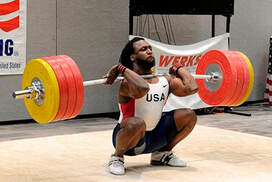One of the problems I see all the time at the gym and get a lot of questions on is the front rack position. Being able to get into a good front rack position is vital for many movements in the gym – front squats, cleans, and pressing/ jerking/ receiving the bar to and from the overhead position. If you lack the ability to get into a solid front rack position, you’re not only going to limit progress, but also putting yourself at risk for injury.

Just to make sure we are all on the same page, the front rack position is when you rack or hold the barbell on your shoulders in front of you. Why is it that so many athletes struggle to accomplish and maintain a good front rack position? More often than not it comes down to mobility issues in the upper body. Many lack the mobility and flexibility to fully achieve the position. The biggest contributing factors are thoracic spine (mid back) restrictions, lat and teres major tightness, stiff triceps, and poor wrist mobility. However, a solid, stable core as well as hip and ankle mobility can play a role as well.
As you can see, there are a lot of reasons why an athlete can suck at the front rack, and it’s easy to go from exercise to exercise and spin your wheels. So, I decided to put together this post to help streamline improving your front rack. Essentially there are two parts: 1 – mobility drills to help improve individual components limiting the front rack, and 2 – mobility drills done in the front rack position itself. I can’t express enough how important it is to spend time in the front rack position itself to improve the front rack. No different that sitting in a deep squat to improve deep squat mobility!

As we start to think through this problem, I want to first call out the most common reasoning error from athletes that I see time and time again. When they struggle with achieving the front rack position, they often feel like their wrist are going to explode! They feel like the wrists are the problem, and immediately begin engaging in various self wrist extension mobilization exercises. The reality, however, is often the wrists are the victim, and not the actual cause of the issue. Forcing the front rack when you don’t have it not only jams the joints and ligaments in the wrist but can cause an extreme amount of neural tension through the carpel tunnel (located right at the base of the wrist) from extreme compression. Ever experience pins and needles the night after a day of high-volume front rack work? Your likely forcing a position your body can’t handle. 9 times out of the 10, it’s not the wrist that’s the issue, so we need look elsewhere.
The following exercises/drills have been beneficial for many of my athletes, clients, and training partners for improving the front rack positioning in weightlifting and CrossFit movements, so I’ve outlined them for you below in order of most common limitations to least common.
1. Thoracic Spine Extension/ Rotation
Many of us sit behind a desk all day in a slightly rounded or hunched thoracic position, making it difficult to extend and achieve a strong, neutral position in their trunk with solid core stability. Thoracic (mid/upper back) extension is a key component of a healthy front rack. While its extension that needs improvement, the thoracic spine facet joints are built more for rotation. Improving thoracic rotation can actually indirectly improve thoracic extension better than directly attacking thoracic extension. Therefore, I recommend you perform an exercise that targets both. Here’s a great example:
2. Latissimus Dorsi Flexibility
The lats (and teres major) play a major role in achieving a full front rack position. In CrossFit especially, these muscle often are over worked and flat out beat up on a regular basis, increasing stiffness over time. Stiff lats can not only prevent you from getting your elbows up, but also limits shoulder external rotation – a KEY component of achieving a solid front rack. Here are two exercises I love to improve this:
3. Wrist Extension Mobility
Last (and probably least), its worth briefly discussing wrist extension mobility. While this is motion is usually not the issue, it can contribute in some cases. Especially if you’ve had a previous wrist injury, and developed some excessive scar tissue, the wrist can get pretty stiff and lead to front rack limitations. Here are two options to help open them up.
Now it’s also important to note that there are other factors can limit the front rack position as well. If you can achieve a solid position in standing, but struggle at the bottom of a front squat or while catching the clean, you likely have a hip or ankle mobility issue (check out our YouTube Channel for great example to improve these). Limitations in core stability, technique and form errors, and inability to generate intra-abdominal pressure, called the Valsalva maneuver, can play a significant role as well.
There you have it. I recommend you pick 1 exercise per body region (choose whichever you fell produces the biggest change for you specifically), make a check list, and spend a few minutes a day 3-5 times a week rolling through them. They are not only effective as a warm-up, but feel free to add them in during rest breaks throughout your front squat or clean session for added mobility work.
Now, this is only half the battle! While adding some additional accessory mobility drills are great, I’m a firm believer that using the loaded front rack position itself, may actually be even more beneficial in achieving that solid front rack position. Not only is working in the front rack obviously going to carry over to using the front when lifting weights, but will have more long term carry over, which is of course most important. No one wants to spend 10 minutes a day for months on end with mobility programs, right? Part 2 dives deep into this topic, see be sure to check it out!
Thanks for reading,
Dr. Andrew

